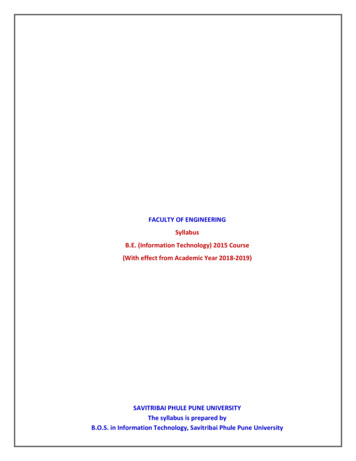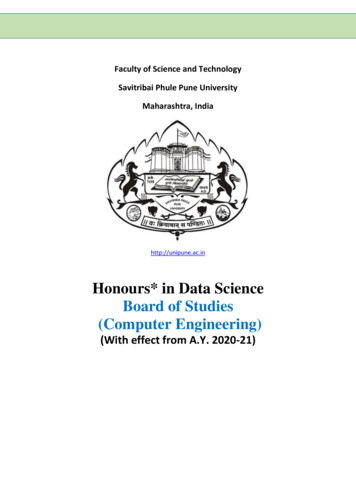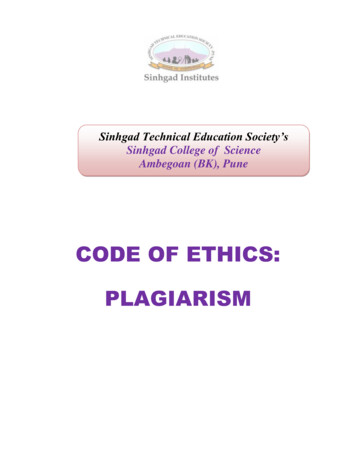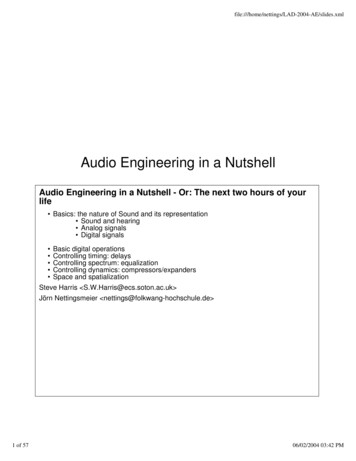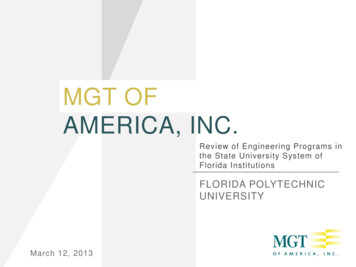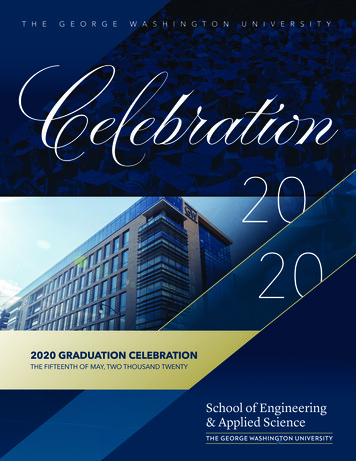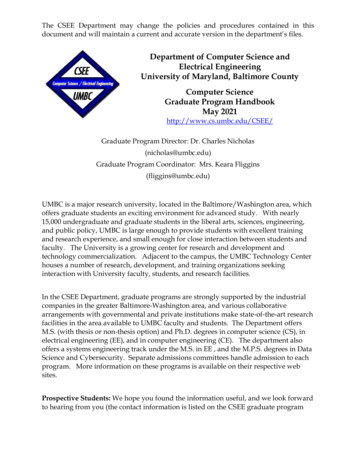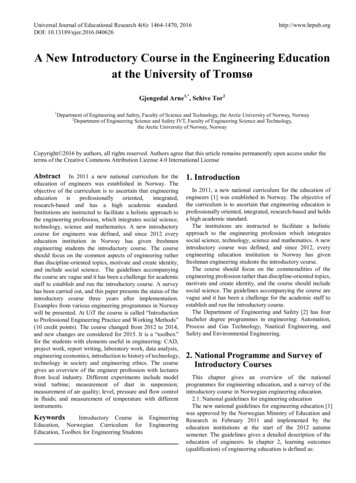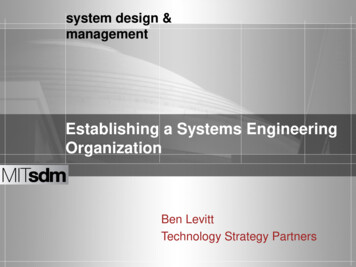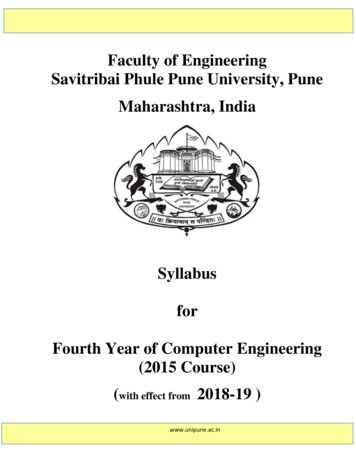
Transcription
Faculty of EngineeringSavitribai Phule Pune University, PuneMaharashtra, IndiaSyllabusforFourth Year of Computer Engineering(2015 Course)(with effect from 2018-19 )www.unipune.ac.in
Faculty of EngineeringSavitribai Phule Pune UniversityPrologueIt is with great pleasure and honor that I share the syllabi for Fourth Year of ComputerEngineering (2015 Course) on behalf of Board of Studies (BoS), Computer Engineering. We,members of BoS are giving our best to streamline the processes and curricula design at both UGand PG programs.It is always the strenuous task to balance the syllabus with the blend of core subjects, currentdevelopments and exotic subjects. By considering all the aspects with adequate prudence thecontents are designed to make the graduate competent enough as far as employability isconcerned. It is absolutely necessary and justified to add sufficient flexibility in the givenconstraints leading the curriculum design near to perfection.It may be highly subjective to include or exclude the courses, but benefit of the learner is alwaysthe nucleus the process. Many thoughts, suggestions, recommendations and directions help us tocome up with the final contents. For the final year finishing touch is absolutely necessary whichis provided with project based learning at the most.I sincerely thank all the minds and hands who work adroitly to materialize these tasks. I reallyappreciate everyone‟s contribution and suggestions in finalizing the contents.Dr. Varsha H. PatilCoordinator, Board of Studies (Computer Engineering), SPPU, Pune[This document contents Program Educational Objectives - Program Outcomes - ProgramSpecific Outcomes(page 3),Courses (teaching scheme, examination, marks and credit)(page4-5), Courses syllabi(page 7-85) and FE to BE courses at a glance(Page 86-87) ].Other related Syllabus Links:Syllabus for First Year Engineering (2015 Course)Syllabus for Second Year Computer Engineering (2015 Course)Syllabus for Third Year Computer Engineering (2015 Course)Syllabus for Fourth Year of Computer Engineering #2/87
Faculty of EngineeringSavitribai Phule Pune UniversitySavitribai Phule Pune University, PuneBachelor of Computer EngineeringProgram Educational Objectives1. To prepare globally competent graduates having strong fundamentals, domain knowledge, updatedwith modern technology to provide the effective solutions for engineering problems.2. To prepare the graduates to work as a committed professional with strong professional ethics andvalues, sense of responsibilities, understanding of legal, safety, health, societal, cultural andenvironmental issues.3. To prepare committed and motivated graduates with research attitude, lifelong learning, investigativeapproach, and multidisciplinary thinking.4. To prepare the graduates with strong managerial and communication skills to work effectively asindividual as well as in teams.Program OutcomesStudents are expected to know and be able –1. To apply knowledge of mathematics, science, engineering fundamentals, problem solving skills,algorithmic analysis and mathematical modeling to the solution of complex engineering problems.2. To analyze the problem by finding its domain and applying domain specific skills3. To understand the design issues of the product/software and develop effective solutions withappropriate consideration for public health and safety, cultural, societal, and environmentalconsiderations.4. To find solutions of complex problems by conducting investigations applying suitable techniques.5. To adapt the usage of modern tools and recent software.6. To contribute towards the society by understanding the impact of Engineering on global aspect.7. To understand environment issues and design a sustainable system.8. To understand and follow professional ethics.9. To function effectively as an individual and as member or leader in diverse teams andinterdisciplinary settings.10. To demonstrate effective communication at various levels.11. To apply the knowledge of Computer Engineering for development of projects, and its finance andmanagement.12. To keep in touch with current technologies and inculcate the practice of lifelong learning.Program Specific Outcomes (PSO)A graduate of the Computer Engineering Program will demonstratePSO1: Professional Skills-The ability to understand, analyze and develop computer programs in theareas related to algorithms, system software, multimedia, web design, big data analytics, and networkingfor efficient design of computer-based systems of varying.PSO2: Problem-Solving Skills- The ability to apply standard practices and strategies in software projectdevelopment using open-ended programming environments to deliver a quality product for businesssuccess.PSO3: Successful Career and Entrepreneurship- The ability to employ modern computer languages,environments, and platforms in creating innovative career paths to be an entrepreneur, and a zest forhigher studies.Syllabus for Fourth Year of Computer Engineering #3/87
Faculty of EngineeringSavitribai Phule Pune UniversitySavitribai Phule Pune UniversityFourth Year of Computer Engineering (2015 Course)(with effect from 2018-19)Semester ICourseCodeCourseTeaching SchemeHours / WeekTheory PracticalExamination Scheme and Marks410241 High PerformanceComputing04--InSem30410242 ArtificialIntelligence andRobotics410243 Data Analytics410244 Elective I410245 Elective II410246 LaboratoryPractice I410247 LaboratoryPractice II410248 Project WorkStage I03--30030303-----04---EndSem70TW PRCreditOR/ ----50--*50100--0202--------*5050--021606Total CreditTotalTH/TUT041015035010050100750Audit Course 5--22GradeElective IElective II410244 (A) Digital Signal Processing410244 (B) Software Architecture and Design410244 (C) Pervasive and Ubiquitous Computing410244 (D) Data Mining and Warehousing410245 (A) Distributed Systems410245 (B) Software Testing and Quality Assurance410245 (C) Operations Research410245 (D) Mobile Communication410249-Audit Course 5 (AC5) Options:AC5-IEntrepreneurship DevelopmentAC5-IV:Industrial Safety and Environment ConsciousnessAC5-II: Botnet of ThingsAC5-V:Emotional IntelligenceAC5-III: 3D PrintingAC5-VI: MOOC- Learn New SkillsAbbreviations:TW: Term WorkTH: TheoryOR: OralSem: SemesterPRE: Project/ Mini-Project PresentationSyllabus for Fourth Year of Computer Engineering PR: Practical#4/87
Faculty of EngineeringSavitribai Phule Pune UniversitySavitribai Phule Pune UniversityFourth Year of Computer Engineering (2015 Course)(with effect from 2018-19)Semester IICourseCodeCourseTeachingSchemeHours / WeekExamination Scheme and MarksTheory Practical410250 Machine Learning03--InSem30410251 Information and CyberSecurity410252 Elective III410253 Elective IV410254 Laboratory Practice III410255 Laboratory Practice IV410256 Project Work Stage EndSem70TW OR/ 100-100-100-100*50100*50150Total Credit100750Audit Course 6--GradeElective IIIElective IV410252 (A) Advanced Digital Signal Processing410253 (A) Software Defined Networks410252 (B) Compilers410253 (B) Human Computer Interface410252 (C) Embedded and Real Time Operating System410253 (C) Cloud Computing410252 (D) Soft Computing and Optimization Algorithms410253 (D) Open Elective410259-Audit Course 6 (AC6) Options:AC6-I: Business IntelligenceAC6-II: GamificationAC6-III: Quantum ComputingAC6-IV: Usability EngineeringAC6-V: Conversational InterfacesAC6-VI: MOOC- Learn New SkillsAbbreviations:TW: Term WorkTH: TheoryOR: OralSem: SemesterPRE: Project/ Mini-Project PresentationSyllabus for Fourth Year of Computer Engineering PR: Practical#5/87
Faculty of EngineeringSavitribai Phule Pune UniversitySEMESTERISyllabus for Fourth Year of Computer Engineering #6/87
Faculty of EngineeringSavitribai Phule Pune UniversityTeaching Scheme:TH: 04 processor,210244-HomeSavitribai Phule Pune UniversityFourth Year of Computer Engineering (2015 Course)410241: High Performance ComputingExamination Scheme:In-Sem (Paper): 30 MarksEnd-Sem (Paper): 70 MarksComputer Organization andArchitecture, 210254-Principles of Programming Languages, 310251- Systems Programming andOperating SystemCompanion Course: 410246-Laboratory Practice ICourse Objectives: To study parallel computing hardware and programming models To be conversant with performance analysis and modeling of parallel programs To understand the options available to parallelize the programs To know the operating system requirements to qualify in handling the parallelizationCourse Outcomes:On completion of the course, student will be able to– Describe different parallel architectures, inter-connect networks, programming models Develop an efficient parallel algorithm to solve given problem Analyze and measure performance of modern parallel computing systems Build the logic to parallelize the programming taskCourse ContentsUnit IMotivatingIntroductionParallelism,Scope09 HoursofParallelComputing,Parallel Programming Platforms: Implicit Parallelism, Trends in Microprocessor andArchitectures, Limitations of Memory, System Performance, Dichotomy of Parallel ComputingPlatforms, Physical Organization of Parallel Platforms, Communication Costs in ParallelMachines, Scalable design principles, Architectures: N-wide superscalar architectures, Multi-corearchitecture.Unit IIParallel Programming09 HoursPrinciples of Parallel Algorithm Design: Preliminaries, Decomposition Techniques, Characteristicsof Tasks and Interactions, Mapping Techniques for Load Balancing, Methods for ContainingInteraction Overheads, Parallel Algorithm Models, The Age of Parallel Processing, the Rise ofGPU Computing, A Brief History of GPUs, Early GPU.Syllabus for Fourth Year of Computer Engineering #7/87
Faculty of EngineeringSavitribai Phule Pune UniversityBasic Communication09 HoursOperations- One-to-All Broadcast and All-to-One Reduction, All-to-All Broadcast andReduction, All-Reduce and Prefix-Sum Operations, Scatter and Gather, All-to-All heSpeedofSomeCommunicationOperations.Unit IVAnalytical Models of Parallel Programs09 HoursAnalytical Models: Sources of overhead in Parallel Programs, Performance Metrics for ParallelSystems, and The effect of Granularity on Performance, Scalability of Parallel Systems, Minimumexecution time and minimum cost, optimal execution time. Dense Matrix Algorithms: MatrixVector Multiplication, Matrix-Matrix Multiplication.Unit VParallel Algorithms- Sorting and Graph09 HoursIssues in Sorting on Parallel Computers, Bubble Sort and its Variants, Parallelizing Quick sort,All-Pairs Shortest Paths, Algorithm for sparse graph, Parallel Depth-First Search, Parallel BestFirst Search.Unit VICUDACUDA 09 HoursApplicationsofCUDAIntroduction to CUDA C-Write and launch CUDA C kernels, Manage GPU memory, Managecommunication and synchronization, Parallel programming in CUDA- C.Books:Text:1.Ananth Grama, Anshul Gupta, George Karypis, and Vipin Kumar, "Introduction toParallel Computing", 2nd edition, Addison-Wesley, 2003, ISBN: 0-201-64865-22. Jason sanders, Edward Kandrot, “CUDA by Example”, Addison-Wesley, ISBN-13: 978-013-138768-3References:1.2.3.4.Kai Hwang, ”Scalable Parallel Computing”, McGraw Hill 1998, ISBN:0070317984Shane Cook, “CUDA Programming: A Developer's Guide to Parallel Computing withGPUs”, Morgan Kaufmann Publishers Inc. San Francisco, CA, USA 2013ISBN: 9780124159884David Culler Jaswinder Pal Singh, ”Parallel Computer Architecture: A Hardware/SoftwareApproach”, Morgan Kaufmann,1999, ISBN 978-1-55860-343-1Rod Stephens, “ Essential Algorithms”, Wiley, ISBN: ISBN: 978-1-118-61210-1Syllabus for Fourth Year of Computer Engineering #8/87HomeUnit III
Faculty of EngineeringSavitribai Phule Pune UniversityHomeSavitribai Phule Pune UniversityFourth Year of Computer Engineering (2015 Course)410242: Artificial Intelligence and RoboticsExamination Scheme:In-Sem (Paper): 30 MarksTH: 03 Hours/WeekEnd-Sem (Paper): 70 MarksPrerequisite Courses: 210254-Principles of Programming LanguagesTeaching Scheme:Credit03Companion Course: 410246-Laboratory Practice ICourse Objectives: To understand the concept of Artificial Intelligence (AI) To learn various peculiar search strategies for AI To acquaint with the fundamentals of mobile robotics To develop a mind to solve real world problems unconventionally with optimalityCourse Outcomes:On completion of the course, student will be able to– Identify and apply suitable Intelligent agents for various AI applications Design smart system using different informed search / uninformed search or heuristicapproaches. Identify knowledge associated and represent it by ontological engineering to plan a strategyto solve given problem. Apply the suitable algorithms to solve AI problemsCourse ContentsUnit IIntroduction08 HoursArtificial Intelligence: Introduction, Typical Applications. State Space Search: Depth BoundedDFS, Depth First Iterative Deepening. Heuristic Search: Heuristic Functions, Best First Search,Hill Climbing, Variable Neighborhood Descent, Beam Search, Tabu Search. Optimal Search: A*algorithm, Iterative Deepening A*, Recursive Best First Search, Pruning the CLOSED and OPENLists.Unit IIProblem Decomposition and Planning08 HoursProblem Decomposition: Goal Trees, Rule Based Systems, Rule Based Expert Systems. Planning:STRIPS, Forward and Backward State Space Planning, Goal Stack Planning, Plan Space Planning,A Unified Framework For Planning. Constraint Satisfaction : N-Queens, Constraint Propagation,Scene Labeling, Higher order and Directional Consistencies, Backtracking and Look aheadStrategies.Syllabus for Fourth Year of Computer Engineering #9/87
Faculty of EngineeringLogic and Reasoning08 HoursKnowledge Based Reasoning: Agents, Facets of Knowledge. Logic and Inferences: Formal Logic,Propositional and First Order Logic, Resolution in Propositional and First Order Logic, DeductiveRetrieval, Backward Chaining, Second order Logic. Knowledge Representation: ConceptualDependency, Frames, Semantic nets.Unit IVNatural Language Processing and ANN08 HoursNatural Language Processing: Introduction, Stages in natural language Processing, Application ofNLP in Machine Translation, Information Retrieval and Big Data Information Retrieval. Learning:Supervised, Unsupervised and Reinforcement learning. Artificial Neural Networks (ANNs):Concept, Feed forward and Feedback ANNs, Error Back Propagation, Boltzmann Machine.Unit VRobotics08 HoursRobotics: Fundamentals, path Planning for Point Robot, Sensing and mapping for Point Robot,Mobile Robot Hardware, Non Visual Sensors like: Contact Sensors, Inertial Sensors, InfraredSensors, Sonar, Radar, laser Rangefinders, Biological Sensing. Robot System Control: Horizontaland Vertical Decomposition, Hybrid Control Architectures, Middleware, High-Level Control,Human-Robot Interface.Unit VIRobots in Practice08 HoursRobot Pose Maintenance and Localization: Simple Landmark Measurement, Servo Control,Recursive Filtering, Global Localization. Mapping: Sensorial Maps, Topological Maps, GeometricMaps, Exploration. Robots in Practice: Delivery Robots, Intelligent Vehicles, Mining Automation,Space Robotics, Autonomous Aircrafts, Agriculture, Forestry, Domestic Robots.Books:Text:1. Deepak Khemani, “A First Course in Artificial Intelligence”, McGraw HillEducation(India), 2013, ISBN : 978-1-25-902998-12. Elaine Rich, Kevin Knight and Nair, “Artificial Intelligence”, TMH, ISBN-978-0-07008770-53. Stuart Russell and Peter Norvig, “Artificial Intelligence: A Modern Approach”, Thirdedition, Pearson, 2003, ISBN :10: 01360425974. Michael Jenkin, Gregory, “ Computational Principals of Mobile Robotics”, CambridgeUniversity Press, 2010, ISBN : 978-0-52-187157-0References:1. Nilsson Nils J , “Artificial Intelligence: A new Synthesis, Morgan Kaufmann PublishersInc. San Francisco, CA, ISBN: 978-1-55-860467-42. Patrick Henry Winston, “Artificial Intelligence”, Addison-Wesley Publishing Company,ISBN: 0-201-53377-43. Andries P. Engelbrecht-Computational Intelligence: An Introduction, 2nd Edition-WileyIndia- ISBN: 978-0-470-51250-0Syllabus for Fourth Year of Computer Engineering #10/87HomeUnit IIISavitribai Phule Pune University
Faculty of EngineeringSavitribai Phule Pune UniversityHomeSavitribai Phule Pune UniversityFourth Year of Computer Engineering (2015 Course)410243: Data AnalyticsTeaching Scheme:Examination Scheme:CreditIn-Sem (Paper): 30 MarksTH: 03 Hours/Week03End-Sem (Paper): 70 MarksPrerequisite Courses: 310242-Database Management SystemsCompanion Course: 410246-Laboratory Practice ICourse Objectives: To develop problem solving abilities using Mathematics To apply algorithmic strategies while solving problems To develop time and space efficient algorithms To study algorithmic examples in distributed, concurrent and parallel environmentsCourse Outcomes:On completion of the course, student will be able to– Write case studies in Business Analytic and Intelligence using mathematical models Present a survey on applications for Business Analytic and Intelligence Provide problem solutions for multi-core or distributed, concurrent/Parallel environmentsCourse ContentsUnit IIntroduction and Life Cycle08 HoursIntroduction: Big data overview, state of the practice in Analytics- BI Vs Data Science, CurrentAnalytical Architecture, drivers of Big Data, Emerging Big Data Ecosystem and new approach.Data Analytic Life Cycle: Overview, phase 1- Discovery, Phase 2- Data preparation, Phase 3Model Planning, Phase 4- Model Building, Phase 5- CommunicateResults, Phase 6-Opearationalize. Case Study: GINAUnit IIBasic Data Analytic Methods08 HoursStatistical Methods for Evaluation- Hypothesis testing, difference of means, wilcoxon rank–sumtest, type 1 type 2 errors, power and sample size, ANNOVA. Advanced Analytical Theory andMethods: Clustering- Overview, Kmeans- Use cases, Overview of methods, determiningnumber of clusters, diagnostics, reasons to choose and cautions.Syllabus for Fourth Year of Computer Engineering #11/87
Faculty of EngineeringSavitribai Phule Pune UniversityAssociation Rules and Regression08 HoursAdvanced Analytical Theory and Methods: Association Rules- Overview, a-priori algorithm,evaluation of candidate rules, case study-transactions in grocery store, validation and testing,diagnostics. Regression- linear, logistics, reasons to choose and cautions, additional regressionmodels.Unit IVClassification08 HoursDecision trees- Overview, general algorithm, decision tree algorithm, evaluating a decision tree.Naïve Bayes – Bayes‟ Algorithm, Naïve Bayes‟ Classifier, smoothing, diagnostics. Diagnosticsof classifiers, additional classification methods.Unit VBig Data Visualization08 HoursIntroduction to Data visualization, Challenges to Big data visualization, Conventional datavisualization tools, Techniques for visual data representations, Types of data visualization,Visualizing Big Data, Tools used in data visualization, Analytical techniques used in Big datavisualization.Unit VIAdvanced Analytics-Technology and Tools08 HoursAnalytics for unstructured data- Use cases, Map Reduce, Apache Hadoop. The HadoopEcosystem- Pig, HIVE, HBase, Mahout, NoSQL. An Analytics Project-Communicating,operationalizing, creating final deliverables.Books:Text:1. David Dietrich, Barry Hiller, “Data Science and Big Data Analytics”, EMC educationservices, Wiley publications, 2012, ISBN0-07-120413-X2. Ashutosh Nandeshwar , “Tableau Data Visualization Codebook”, Packt Publishing, ISBN978-1-84968-978-6References:1. ,McGrawHill,ISBN:789353160258.2. Mark Gardner, “Beginning R: The Statistical Programming Language”, Wrox Publication,ISBN: 978-1-118-16430-33. Luís Torgo, “Data Mining with R, Learning with Case Studies”, CRC Press, Talay andFrancis Group, ISBN97814822348934. Carlo Vercellis, “Business Intelligence - Data Mining and Optimization for DecisionMaking”, Wiley Publications, ISBN: 9780470753866.Syllabus for Fourth Year of Computer Engineering #12/87HomeUnit III
Faculty of EngineeringSavitribai Phule Pune UniversityTeaching Scheme:TH: 03 Hours/WeekCredit03HomeSavitribai Phule Pune UniversityFourth Year of Computer Engineering (2015 Course)Elective I410244(A): Digital Signal ProcessingExamination Scheme:In-Sem (Paper): 30 MarksEnd-Sem (Paper): 70 MarksPrerequisite Courses: 207003- Engineering Mathematics IIICompanion Course: 410247-Laboratory Practice IICourse Objectives: To Study and understand representation and properties of signals and systems. To learn methodology to analyze signals and systems To study transformed domain representation of signals and systems To explore Design and analysis of Discrete Time (DT) signals and systems To Understand Design of filters as DT systems To get acquainted with the DSP Processors and DSP applicationsCourse Outcomes:On completion of the course, student will be able to– Understand the mathematical models and representations of DT Signals and Systems Apply different transforms like Fourier and Z-Transform from applications point of view. Understand the design and implementation of DT systems as DT filters with filter structuresand different transforms. Demonstrate the knowledge of signals and systems for design and analysis of systems Apply knowledge and use the signal transforms for digital processing applicationsCourse ContentsUnit ISignals and Systems08 HoursContinuous time (CT), Discrete-time (DT) and Digital signals, Basic DT signals and Operations.Discrete-time Systems, Properties of DT Systems and Classification, Linear Time Invariant (LTI)Systems, Impulse response, Linear convolution, Linear constant coefficient difference equations,FIR and IIR systems, Periodic Sampling, Relationship between Analog and DT frequencies,Aliasing, Sampling Theorem, A to D conversion Process: Sampling, quantization and encoding.Unit IIFrequency Domain Representation of Signal08 HoursIntroduction to Fourier Series, Representation of DT signal by Fourier Transform (FT), Propertiesof FT: Linearity, periodicity, time shifting, frequency shifting, time reversal, differentiation,convolution theorem, windowing theorem Discrete Fourier Transform (DFT), DFT and FT, IDFT,Twiddle factor, DFT as linear transformation matrix, Properties of DFT, circular shifting, CircularConvolution, DFT as Linear filtering, overlap save and add, DFT spectral leakage.Unit IIIFast Fourier Transform (FFT) and Z-Transform (ZT)Syllabus for Fourth Year of Computer Engineering 08 Hours#13/87
Faculty of EngineeringSavitribai Phule Pune UniversityFFT, Z-transform (ZT), ZT and FT, ZT and DFT, ROC and its properties,ZT Properties,convolution, initial value theorem, Rational ZT, Pole Zero Plot, Behavior of causal DT signals,Inverse Z Transform (IZT): power series method, partial fraction expansion (PFE) , Residuemethod.Unit IVAnalysis of DT - LTI Systems08 HoursSystem function H(z), H(z) in terms of Nth order general difference equation, all poll and all zerosystems, Analysis of LTI system using H(Z), Unilateral Z-transform: solution of differenceequation, Impulse and Step response from difference equation, Pole zero plot of H(Z) anddifference equation, Frequency response of system, Frequency response from pole-zero plot usingsimple geometric construction.Unit VDigital Filter Design08 HoursConcept of filtering, Ideal filters and approximations, specifications, FIR and IIR filters, Linearphase response, FIR filter Design: Fourier Series method, Windowing method, Gibbs Phenomenon,desirable features of windows, Different window sequences and its analysis, Design examples IIRfilter design: Introduction, Mapping of S-plane to Z-plane, Impulse Invariance method, Bilinear Ztransformation (BLT) method, Frequency Warping, Pre-warping, Design examples, Comparison ofIIR and FIR Filters.Unit VIFilter Structures and DSP Processors08 HoursFilter Structures for FIR Systems: direct form, cascade form, structures for linear phase FIRSystems, Examples, Filter structures for IIR Systems: direct form, cascade form, parallel form,Examples DSP Processors: ADSP 21XX Features, comparison with conventional processor, BasicFunctional Block diagram, SHARC DSP Processor Introduction to OMAP (Open MultimediaApplication Platform).Books:Text:1. Proakis J, Manolakis D, "Digital Signal Processing", 4th Edition, Pearson Education, ISBN97881317100052. Oppenheium A, Schafer R, Buck J, "Discrete time Signal Processing", 2nd Edition, PearsonEducation, ISBN 9788131704929Reference:1. Mitra S., "Digital Signal Processing: A Computer Based Approach", Tata McGraw-Hill,1998, ISBN 0-07-044705-52. Ifleachor E. C., Jervis B. W., “Digital Signal Processing: A Practical Approach “, PearsonEducation, 2002, , ISBN-13: 978-0201596199,ISBN-10: 02015961993. S. Salivahanan, A. Vallavaraj, C. Gnanapriya, "Digital Signal Processing", McGraw-Hill,ISBN 0-07-463996-X4. S. Poornachandra, B. Sasikala, “Digital Signal Processing”,3rd Edition, McGraw-Hill,ISBN-13:978-07- 067279-6Syllabus for Fourth Year of Computer Engineering #14/87HomeEffective computation of DFT, Radix-2 FFT algorithms: DIT FFT, DIF FFT, Inverse DFT using
Faculty of EngineeringSavitribai Phule Pune UniversityHomeSavitribai Phule Pune UniversityFourth Year of Computer Engineering (2015 Course)Elective I410244(B): Software Architecture and DesignExamination Scheme:In-Sem (Paper): 30 MarksEnd-Sem (Paper): 70 MarksPrerequisite Courses: 310243- Software Engineering and Project ManagementTeaching Scheme:TH: 03 Hours/WeekCredit03Companion Course: 410247-Laboratory Practice IICourse Objectives: To introduce basic concepts and principles about software design and software architecture To learn practical approaches and methods for creating and analyzing software architecture To acquaint with the interaction between quality attributes and software architecture To experience with examples in design pattern application and case studies in softwarearchitectureCourse Outcomes:On completion of the course, student will be able to– Express the analysis and design of an application Specify functional semantics of an application Evaluate software architectures Select and use appropriate architectural styles and software design patternsCourse ContentsUnit IIntroduction08 HoursIntroduction to Software Architecture, Architecture Business Cycle- Where do architecture come from,Software processes and the Architecture Business cycle, What makes Good Architecture. What issoftware architecture- What Software Architecture is and what it is not, Other points of View,Architectural Patterns, Reference Models, Reference Architectures, Why is Software Architectureimportant, Architectural structure and Views. Case Study-A-7E Avionics System.Unit IIQuality Attributes08 HoursIntroduction to Quality Attributes, Understanding quality attributes- Functionality and Architecture,architecture and quality attributes, System Quality Attributes, Quality Attribute Scenario in Practice,Other System Quality Attributes, Business Qualities, and Architecture Qualities. Achieving qualityattributes- Introducing Tactics, Availability tactics, Modifiability tactics, Performance tactics, Securitytactics, Testability tactics, Usability tactics, Relationship of tactics to Architectural patterns, ArchitecturalPatterns and Styles. Case study- Air Traffic Control.Syllabus for Fourth Year of Computer Engineering #15/87
Faculty of EngineeringSavitribai Phule Pune University08 HoursArchitecture in Life Cycle, Designing the Architecture, Forming the team structure, Creating a skeletalsystem, Case Study- Flight Simulation. Design Patterns: What is Design Pattern?, Describing DesignPatterns, The Catalog of Design Patterns, Organizing the Catalog, How Design patterns solves designproblems, How to select Design Patterns, How to use Design Patterns.Unit IVDesign Pattern Catalog08 HoursCreational Patterns- Abstract Factory, Singleton. Structural Patterns- Adaptor, Facade, Proxy. BehavioralPatterns- Chain of Responsibility, Iterator, Mediator, Observer. What to expect from Design Patterns.Unit VClient Side Technologies08 HoursIntroduction to three tier and n-Tier Web Architectures, Need of Client side technology in multi-tierarchitectures, XML, Client side technologies- HTML, DHTML, Java Applets, Active X controls, DOM,AJAX. Case study-Mobile or portable client side technologies.Unit VIMiddleware and Server Side Technologies08 HoursIntroduction to Middleware, Types of Middleware, Application servers, Introduction to Java EE,Introduction to Java EE technologies like JMS, JDBC, RPC, RMI, SOCKET. EJB 3.0 Architecture,Entity, Session, Message beans, XML, XSLT. Specifications and characteristics of Middlewaretechnologies. Server Side Technologies- Need of server side technology in multi-tier architectures, JavaWeb Services, Server side technologies: JSP, JSF, SOA, MVC. Java Servlets, struts.Books:Text:1. Len Bass, Paul Clements, Rick Kazman, ''Software Architecture in Practice", Second Edition,Pearson ,ISBN 978-81-775-8996-22. Erich Gamma, “Design Patterns”, Pearson, ISBN 0-201-63361-2.3. Kogent, “Java Server Programming Black Book”, Dream Tech Press, PHI Publications, ISBN:978-81-7722-835-9.References:1. James L. Weaver, Kevin Mukhar, "Beginning J2EE 1 .4: From Novice to Professional”, ISBN10: 1590593413, ISBN-13: 978-15905934172. Richard N.Taylor , Nenad M., “Software Architecture Foundation Theory and practice”, WileyISBN: 978-81-265-2802-8.3. Java6 Programming, Black Book DreamTech Press, ISBN:978-81-7722-736-9Syllabus for Fourth Year of Computer Engineering #16/87HomeUnit III Designing the Architectures and Introduction to Design Patterns
Faculty of EngineeringSavitribai Phule Pune UniversityTeaching Sch
A graduate of the Computer Engineering Program will demonstrate- PSO1: Professional Skills-The ability to understand, analyze and develop computer programs in the areas related to algorithms, system software, multimedia, web design, big data analytics, and networking for efficient design
